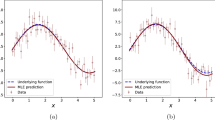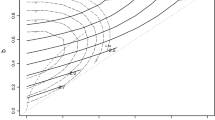Summary
Many experiments or observations measure physical quantities indirectly so that considerable data reduction is required for their interpretation. We present an approach to this problem of data analysis which is based on the transformation of the measurements into the result of a hypothetical experiment designed to measure the physical quantity directly. The method, which greatly appeals to physical intuition, gives the estimates of the desired physical quantity as a direct measurement of that quantity averaged over a resolution function. We are guided to this result by an examination of the characteristics common to all experiments rather than by the introduction of arbitrary mathematical criteria. Even though we approach the problem of data analysis from an entirely new point of view, the mathematics in much of the development parallels that of the method of Backus and Gilbert. No apriori assumptions are made about the physical quantity being estimated and in this sense the method is model independent. The method is applied to the test problem of determining the second derivative of experimental data.
Riassunto
Molti esperimenti o osservazioni misurano quantità fisiche indirettamente, quindi è necessaria una notevole riduzione di dati per interpretarle. Si presenta un'approccio a questo problema di analizzare i dati basati sulla trasformazione delle misure nel risultato di un ipotetico esperimento progettato per misurare direttamente la quantità fisica. Il metodo, che fa appello all'intuito fisico, fornisce una stima della quantità fisica desiderata come misura diretta di quella quantità mediata rispetto ad una funzione di risoluzione. Siamo portati a questo risultato da un esame delle caratteristiche comuni a tutti gli esperimenti piuttosto che dall'introduzione di criteri matematici arbitrari. Anche se si affronta il problema dell'analisi dei dati da un punto di vista completamente nuovo, la matematica in gran parte dello sviluppo è equivalente a quella del metodo di Backus e Gilbert. Non c'è nessun assunto a priori sulla quantità fisica stimata e in questo senso il metodo è indipendente dal modello. Si applica il metodo al problema test di determinare la derivata seconda dei dati sperimentali.
Резюме
В многих экспериментах и наблюдениях измерения физических величин производятся косвенно, так что требуются значительные преобразования для их интерпретации. Мы предлагаем подход к проблеме анализа данных, который основан на преобразовании измерений в результат гипотетического эксперимента, поставленного для непосредственного измерения физической величины. Предложенный метод, который апеллирует в основном, к физической интуиции, дает оценку желаемой физической величины, как результат прямого измерения этой величины, усредненный по разрешающей функции. Этот результат получен при исследовании характеристик, общих для всех экспериментов, а не в результате введения произвольного математического критерия. Даже если мы подходили к проблеме анализа данных полностью с новой точки зрения, математика в нашем подходе аналогична методу Бакуса и Гильберта. Не делается, а приори, никаких предложений об исследуемой физической величине и, в этом смысле, предложенный метод не зависит от модели. Предложенный метод применяется для определения второй производной экспериментальных данных.
Similar content being viewed by others
References
A. N. Tikhonov andV. Y. Arsenin:Solution of Ill-Posed Problems (John Wiley and Sons, New York, N. Y., 1977).
W. I. Beavers, J. J. Eitter, P. H. Carr andB. C. Cook:Astrophys. S.,238, 349 (1980).
B. C. Cook andT. A. Weber:Lett. Nuovo Cimento,39, 119 (1984).
S. Haykin (Editor):Nonlinear Methods of Sepetral Analysis, (Springer-Verlag, Berlin, 1979).
B. C. Cook:Nucl. Instrum. Methods,24, 256 (1963).
G. E. Backus andJ. F. Gilbert:Geophys. J. R. Astron. Soc.,46, 169 (1968).
J. Cullum:SIAM (Soc. Ind. Appl. Math.) J. Numer. Anal.,8, 1035 (1971).
Author information
Authors and Affiliations
Additional information
To speed up publication, the authors of this paper have agreed to not receive the proofs for correction.
Traduzione a cura della Redazione.
Переведено редакцией.
Rights and permissions
About this article
Cite this article
Cook, B.C., Weber, T.A. Model-independent method of data analysis. Nuov Cim B 94, 175–192 (1986). https://doi.org/10.1007/BF02759756
Received:
Published:
Issue Date:
DOI: https://doi.org/10.1007/BF02759756




